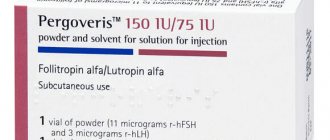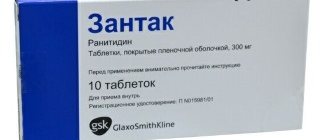According to research in our country, 15-35% of people experience allergic reactions[1]. Unfortunately, even small children are not immune from allergies. Due to imperfect immunity, the child’s body demonstrates an increased reaction to various substances.
There are enough allergens around the child. This includes food, dust, fur, and even animal secretions (for example, saliva). Allergic reactions are also provoked by plant pollen, chemical substances (washing powders, detergents), sunlight and medications. A child’s body may react inadequately to an insect bite and even to cold [2,3].
Pharmacological properties
Pharmacodynamics
A competitive histamine antagonist, a metabolite of hydroxyzine, blocks histamine H1 receptors. Prevents the development and facilitates the course of allergic reactions, has antipruritic and antiexudative effects. Affects the early stage of allergic reactions, limits the release of inflammatory mediators at the “late” stage of the allergic reaction, reduces the migration of eosinophils, neutrophils and basophils. Reduces capillary permeability, prevents the development of tissue edema, relieves spasm of smooth muscles.
Eliminates skin reactions to the introduction of histamine, specific allergens, as well as to cooling (with cold urticaria). Reduces histamine-induced bronchoconstriction in mild bronchial asthma.
It has virtually no anticholinergic and antiserotonin effects.
In therapeutic doses it practically does not cause a sedative effect. The onset of the effect after a single dose of 10 mg of cetirizine is 20 minutes, lasts more than 24 hours. During the course of treatment, tolerance to the antihistamine effect of cetirizine does not develop. After stopping treatment, the effect lasts up to 3 days.
Pharmacokinetics
Rapidly absorbed from the gastrointestinal tract, the time to reach maximum concentration (TCmax) after oral administration is about 1 hour. Food does not affect the completeness of absorption (AUC), but prolongs TCmax by 1 hour and reduces the maximum concentration (Cmax) by 23% . When taken at a dose of 10 mg once a day for 10 days, the equilibrium concentration of the drug (Css) in plasma is 310 ng/ml and is observed 0.5–1.5 hours after administration. Plasma protein binding is 93% and does not change with cetirizine concentrations in the range of 25–1000 ng/ml. The pharmacokinetic parameters of cetirizine change linearly when administered at a dose of 5–60 mg. Volume of distribution – 0.5 l/kg.
In small quantities, it is metabolized in the liver by O-dealkylation to form a pharmacologically inactive metabolite (unlike other H1-histamine receptor blockers, which are metabolized in the liver with the participation of the cytochrome P450 system). Cetirizine does not accumulate. About 2/3 of the drug is excreted unchanged by the kidneys and about 10% in the feces.
Systemic clearance – 53 ml/min. The half-life (T1/2) in adults is 10 hours, in children 6–12 years old – 6 hours, 2–6 years old – 5 hours, 0.5–2 years old – 3.1 hours. In elderly patients, T1/2 increases by 50%, systemic clearance is reduced by 40% (decreased renal function).
In patients with impaired renal function (creatinine clearance below 40 ml/min), drug clearance decreases and T1/2 lengthens (for example, in patients on hemodialysis, the total clearance decreases by 70% and is 0.3 ml/min/kg , and T1/2 is extended by 3 times), which requires a corresponding change in the dosage regimen. It is practically not removed during hemodialysis.
In patients with chronic liver diseases (hepatocellular, cholestatic or biliary cirrhosis), an increase in T1/2 by 50% and a decrease in total clearance by 40% are observed (adjustment of the dosage regimen is required only with a concomitant decrease in glomerular filtration rate). Passes into breast milk.
Indications
Cetirizine is prescribed to relieve symptoms of various forms of allergies.
When to take the medicine:
- seasonal or chronic allergic rhinitis - the drug relieves nasal congestion, lacrimation, itching and sneezing;
- cold, idiopathic urticaria;
- redness and swelling of the skin, the appearance of blisters that appear during allergy tests;
- mild forms of bronchial asthma;
- angioedema;
- severe itching that occurs with allergic dermatoses.
The syrup additionally helps with Quincke's edema.
Use during pregnancy and breastfeeding
Pregnancy
When analyzing prospective data on pregnancy outcomes, no cases of malformations, embryonic and neonatal toxicity with a clear cause-and-effect relationship were identified.
Animal studies have not revealed any direct or indirect adverse effects of cetirizine on the developing fetus (including in the postnatal period), pregnancy and childbirth.
There have been no controlled clinical studies on the safety of the drug during pregnancy, therefore cetirizine should not be used during pregnancy.
Breast-feeding
Cetirizine is excreted in breast milk in concentrations representing from 25% to 90% of the drug concentration in the blood plasma, depending on the time of administration. During breastfeeding, the drug is used after consultation with a doctor, if the expected benefit to the mother outweighs the potential risk to the child.
Fertility
Available data on the effects on human fertility are limited, but no adverse effects on fertility have been identified.
Advantages of "Cetrina"
"Cetrin" for allergies is used quite often. And this is not surprising, since this drug has a number of additional advantages:
- quickly eliminates minor bronchoconstriction;
- effectively reduces the skin's reaction to low temperatures, making it possible to successfully combat allergies to cold;
- perfectly eliminates even severe itching;
- helps with sun allergies;
- can be used after any insect bites;
- prescribed for neurodermatitis.
An undoubted advantage is that Cetrin can be taken by people with diabetes!
Directions for use and doses
Orally, regardless of food intake, without chewing, the tablets are taken with 200 ml of water.
Adults – 10 mg (1 tablet) 1 time a day or 5 mg (1/2 tablet) 2 times a day.
Children over 6 years old – 5 mg (1/2 tablet) 2 times a day or 10 mg (1 tablet) 1 time a day.
In patients with reduced renal function (creatinine clearance 30–49 ml/min), 5 mg/day (1/2 tablet) is prescribed, in severe chronic renal failure (creatinine clearance 10–30 ml/min) – 5 mg/day ( 1/2 tablet) every other day.
How to take Cetrin®:
- Regardless of food intake.
- Take one tablet (10 mg) per day or 0.5 tablets (5 mg) twice a day with plenty of water.
- 3. If a side effect occurs, discontinue the drug.
Another reason for the popularity of the drug Cetrin® among parents is the low risk of side effects. The drug is a 2nd generation antihistamine and is well tolerated by children. Only in isolated cases may reactions occur from the central nervous system (drowsiness, dizziness, etc.), gastrointestinal tract (discomfort, dry mouth), allergic manifestations (rash, urticaria, itching, etc.).
For more detailed information about contraindications and side effects, please refer to the instructions for medical use.
Bibliography:
[1] Pariyskaya T.V. Allergy. Mom, I want to be healthy! / T. V. Pariyskaya. – M.: Eksmo, 2009. – 95 p.
[2] Dranik G.N., Clinical allergology and immunology: a manual for doctors / G.N. Dranik. – M.: Publishing house Medical Information Agency, 2003. – 604 p.
[3] Patterson R., Allergic diseases: diagnosis and treatment. / R. Patterson, L. K. Grammer, P. A. Greenberg; edited by A. G. Chuchalina. - M.: GEOTAR MEDICINE, 2000. - 768 p.
[4] National program “Bronchial asthma in children. Treatment strategy and prevention” / ed. ed. A. G. Chuchalina. – 3rd ed., revised. and additional - M.: Publishing House Atmosphere, 2008. - 108 p.
[5] Federal clinical recommendations for the diagnosis of allergic diseases // Russian organization of allergists and clinical immunologists (RAACI). – Moscow, 2015. – 9-12 p.
[6] Instructions for use of the medicinal product for medical use Cetrin®. – Registration number: P N013283/01.
[7] Cetrin® [Electronic resource] / Access mode: https://grls.rosminzdrav.ru / (Last access date 11/09/2017).
special instructions
You should not use the drug if you need to drive a car or other vehicles, work with complex mechanisms or engage in other activities that require increased attention. This is due to the fact that the drug has a sedative effect and can reduce the speed of reactions.
Cetrine
The simultaneous use of Cetrin with ethanol is allowed if its concentration does not exceed 0.8 g/l. Despite this, it is best to abstain from alcohol completely. Ethanol not only affects the effectiveness of therapy, but also has a bad effect on the child’s health.
Contraindications
The drug should not be used in patients with known hypersensitivity to cetirizine , hydroxyzine or the auxiliary components of the syrup/tablets, or in pregnant or lactating women.
In pediatrics, syrup is prescribed from the age of two, and tablets from the age of six.
Relative contraindications are old age and chronic renal failure . For patients with chronic renal failure and the elderly, the dosage of the drug is selected individually depending on the functional state of the kidneys.
Release form
The manufacturer produces the medicine in the form:
- film-coated tablets 10 mg (packaging No. 20 or No. 30);
- syrup 1 mg/ml (bottles 30 and 60 ml).
Tablets are round, biconvex, film-coated. Their color varies from almost white to white. There is a risk on one side.
Syrup is a transparent, slightly yellowish (or colorless) substance with a pleasant fruity odor. There are no visible particles and the liquid may be slightly opalescent.
Precautionary measures
According to the instructions, Cetrin is prohibited from taking in the following cases:
- Hypersensitivity to components.
- Children under 2 years old (syrup).
- Children under 6 years of age (tablets).
In addition, antihistamines should not be used during lactation.
If there are contraindications or the dosage is independently exceeded, adverse reactions occur:
- headache;
- dizziness;
- lethargy;
- sleep disorders;
- trembling of limbs;
- stressful conditions;
- abdominal pain;
- bloating.
Some patients complain of xerostomia (lack of saliva in the mouth), nausea, vomiting, increased heart rate, and increased blood pressure.
The drug is not recommended to be combined with sedative medications.
Otherwise, an overdose is possible: drowsiness, hand tremors, itching, increased heart rate, ischuria (urinary retention). If such symptoms occur, you should stop taking the drug, consult a doctor and rinse your stomach. In addition, it is necessary to take enterosorbents, for example, Polysorb.
Analogs
The following drugs with similar properties can replace Cetrin during lactation:
| Name | Compound | Release form | Cost in rub. |
| Erius | desloratadine | pills | 550 |
| Zyrtec | Cetirizine dihydrochloride | drops | 90 |
| Claritin | loratadine | syrup, tablets | 250 |
| Levocetirizine | Levocetirizine dihydrochloride | pills | 320 |
| Tavegil | Clemastine hydrofumarate | pills | 150 |
All of these remedies are used with caution during breastfeeding. It is important to consult your doctor.
Drug interactions
The combination of the active substance with theophylline is not recommended, since in certain doses (from 400 mg per day) it affects how quickly cetirizine is eliminated from the body, further retaining it in the blood.
Concomitant use of the drug with myelotoxic drugs is contraindicated. They lead to increased ability of cetirizine to disrupt cell functions.
Compound
Cetrin tablets contain 10 mg of cetirizine hydrochloride , as well as corn starch, lactose, povidone K30, and magnesium stearate.
Tablet shell composition: hypromellose, titanium dioxide, sorbic acid, talc, macrogol 6000, dimethicone , polysorbate 80.
Cetrin syrup contains the active substance at a concentration of 1 mg/ml. The auxiliary components of the drug include: benzoic acid, sucrose, glycerin, disodium edetate, sorbitol solution, sodium citrate, ID20181PH fruit flavoring mixture, purified water.
Citrine overdose
The risk of overdose increases if you take more than four allergy pills at a time.
Symptoms of overdose are:
- Rashes and itching.
- Drowsiness.
- Anxiety (psychomotor agitation).
- Problems with urination.
- Weakness, feeling of constant fatigue.
- Tremor.
- Increased heart rate.
To eliminate the manifestations of this condition, the first step is to lavage the victim’s stomach. Hemodialysis is not recommended because it is not effective in removing Citrine from the blood.
It is possible to take symptomatic medications as prescribed by a specialist, aimed at maintaining the vital functions of the body.
Description of Cetrina
Price
The cost of the drug largely depends on the pricing policy of a particular pharmacy and the size of the package. So, a pack of 20 tablets. will cost about 150 rubles. Price per pack of 30 tablets. can reach 250 rubles.
Cetrin is an antihistamine that helps eliminate allergy symptoms. The possibility of its use during breastfeeding is determined by a doctor, since only a specialist familiar with the individual health characteristics of a woman and her child can prescribe a safe dose.
General information about the drug
In recent years, the number of patients diagnosed with allergies has begun to increase. Increasingly, the population suffers not only from plant pollen and animal hair, but also from atypical increased sensitivity to temperature changes (allergy to the sun, frost). The unpleasant symptoms that accompany the pathological condition develop against the background of increased histamine production. The phenomenon can be eliminated and the patient’s condition can be normalized only with the help of antihistamines. "Cetrin" has a powerful anti-edematous and antipruritic effect.
What do these pills help with? The antiallergic drug belongs to the second generation and can relieve the patient from the discomfort caused by the disease. The drug belongs to the group of selective histamine blockers.
Duration of admission
The duration of taking Cetrin in most cases depends on the severity and nature of the allergy. In this case, you should know that:
- if the treatment of an allergic reaction is also accompanied by diagnostic tests, then the medication must be stopped at least 3 days before the procedure;
- for acute allergic reactions, the drug is taken for about 14 days;
- the standard course is 14-28 days;
- It is not advisable to take this medicine for more than a month; the course can only be extended by a doctor for medical reasons.








